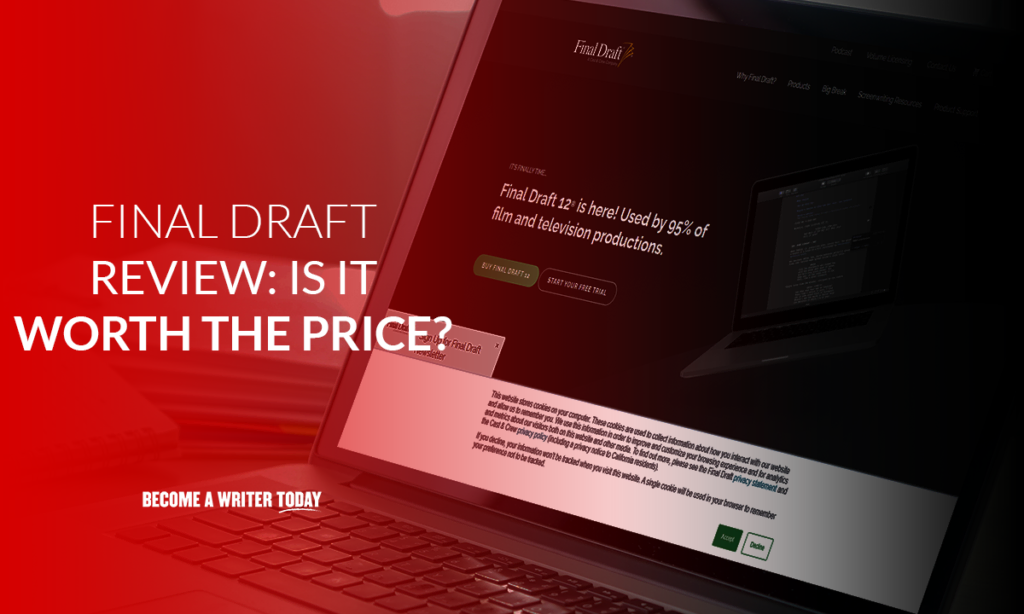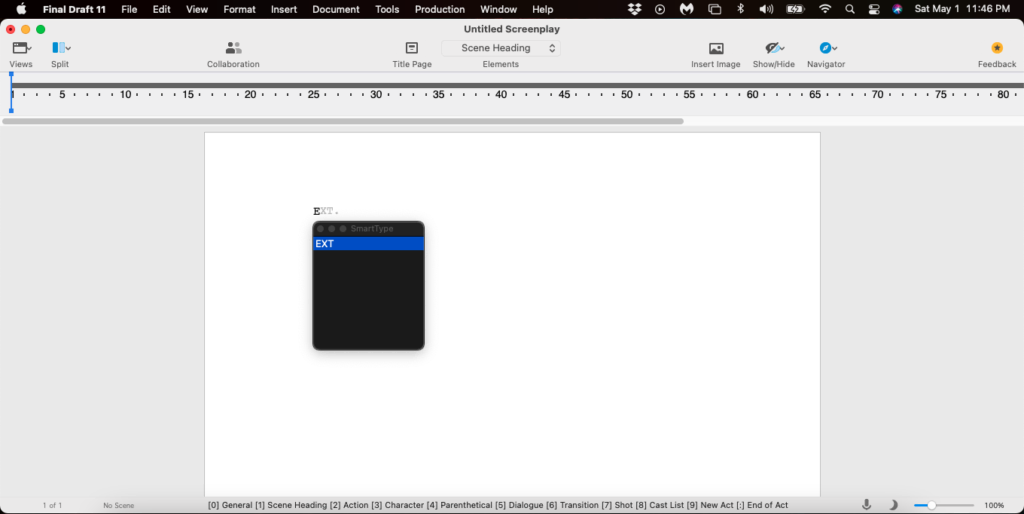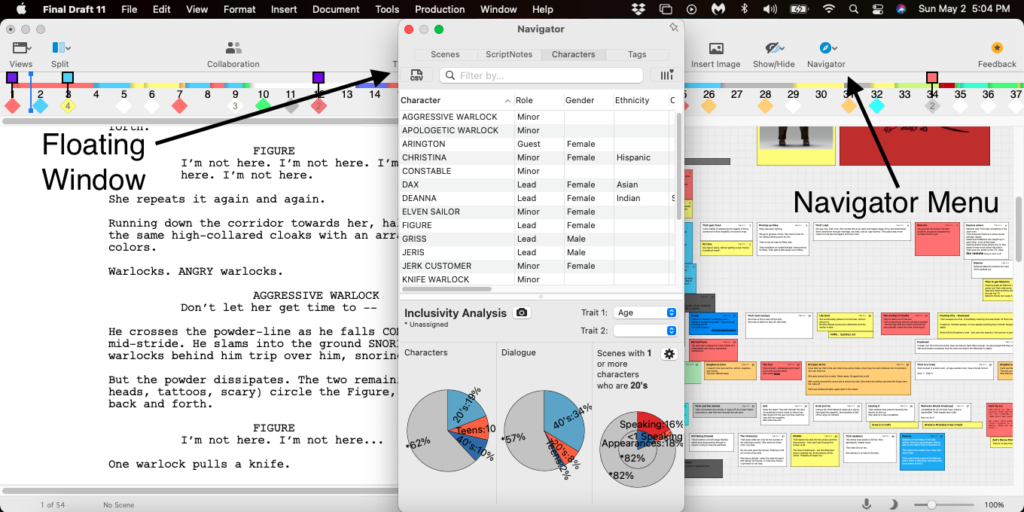Summary
Finally Draft is a good choice for aspiring, new and professional screenwriters. It’s industry-standard for a reason.
Pros
Instantly formats your screenplay for you
The industry standard for 30 years and used in 95% of all film and TV productions
Will generate reports and charts for breakdown and analysis of your story
Allows real-time collaboration with other writers
Cons
This Final draft review explains why it is a pricey but comprehensive software and goes over why it’s considered the best in the industry.
When I’m not writing advertising copy at ludicrous speed, I’m an aspiring comedy scriptwriter who’s been using Final Draft for several years.
In this article, I’ll go over what sets Final Draft apart from other screenwriting programs, how to learn all its bells and whistles, and whether it’s the right software for your screenwriting goals.
Note: This review covers Final Draft 11. New features in the just-released version 12 include:
- The Story Map has been renamed the Outline Editor and now contains multiple lanes, is resizable and more interactive with the rest of the software
- The Beat Board is closer to a flow chart; beats are totally customizable, quick to duplicate or stack inside each other and you can draw color-coded lines between them
- ScriptNotes now appear as flags right on the script pages and can be edited instantly in a popup menu
- Collaboration has been expanded and now allows you to store multiple versions of lines as well as accept or reject edits from other collaborators
Contents
What Is Final Draft?

Media companies including Disney, Netflix, and the BBC use Final Draft to script everything from low-budget reality shows to blockbuster superhero trilogies. It’s considered the industry standard for professional screenwriters and media corporations across the globe.
It’s a word processor designed especially for writing scripts using submission standards developed by the entertainment industry.
Final Draft can be used to write screenplays, stage plays, musicals, and graphic novels, as well as simple text documents like query letters and outlines.
It’s available on Mac, Windows, and iOS.
Pricing
Price is one of the major issues with Final Draft; it normally costs $250 dollars, although at the time of this review it’s on sale for $199 because of the newly released version 12.
The software is license-based. You’re purchasing one license to use a specific version of Final Draft (always the most recent).
Previous versions can be used forever as long as they are compatible with the operating system your computer is running. However, much older versions may not work on computers with newer operating systems.
If you need to upgrade to a newer version, you can get one for less than half the cost of a new license.
Other Software Prices
Other programs are less expensive but not nearly as widely used, and their pricing structures differ.
- Celtx uses a subscription model—you pay monthly or yearly to use their cloud-based app. They offer a free 7-day trial, after which you need to subscribe.
- WriterDuet has a stripped-down free version. You’re limited to 3 scripts at a time and you can’t work offline. To get the full version you need to pay for a monthly subscription.
- FadeIn lets you download a trial version that doesn’t have real-time collaboration and all scripts will have a large watermark. You have to purchase a license to remove the watermark and use the collaboration features. It’s also half the price of Final Draft but does not paginate well in my opinion, especially if you’re importing scripts or collaborating.
These programs will also format for you, but nearly as perfectly as Final Draft does.
You can open scripts using Final Draft‘s file format .fdx in other programs, but the pagination is sometimes incorrect; a 100-page screenplay in Final Draft may open as a 110-page script in another program.
Getting Started
When you open the program, the first thing that pops up is the default document: A blank screenplay page using standard Hollywood script format. You can either start writing here immediately or choose from a number of templates included with the software.
Templates are designed to help you conform to the script formatting used in different industries. They range from Broadway Musicals to TV sitcoms to BBC productions.
There are also options for writing query letters, outlines, manuscripts, and graphic novels.
You can apply a template to a finished script, and it will restructure to fit perfectly within the new parameters. This is great if you started writing a sitcom, for instance, and then later decide it’s better as a full-length film.
Writing Your First Line
The SmartType menus in the processor make formatting a breeze. It uses a tab-and-enter functionality as most scriptwriting software does, but the pop-up menus add an extra layer of convenience.
Here’s how to write your master scene heading:
- Type the letters I or E (for interior or exterior). A SmartType menu pops up, offering you the abbreviation you’re looking for.
- Hit tab, and it will pop it onto the first line. Now just type your location, time of day, and hit enter.

As you write your script, the SmartType menus save your locations and character names.
When you start a new line, the menu will pop up with all the options you’ve written so far and allow you to choose one without having to type it in.
This basic word processor is the core part of the software. It’s intuitive to use and quick to get the hang of.
Delving Into The Features
When I first started screenwriting, I only used the processor part of the program.
I was slightly overwhelmed by all the bells and whistles that come with Final Draft and didn’t delve into them until I felt really comfortable.
Once I developed a bit more confidence, I ventured into some of the other features and I was amazed at how complex the software really is!
There so many little tools you can use to organize your script, break it down, and track various aspects of your story as you breathe life into it.
Here are a few of my favorite features.
Features
The Story Map
This is a linear representation of your script that sits above your writing space; it allows you to visually see your storyline and connect other features to specific points in your script. You can keep track of your story pacing and script length with it.
I personally find this the most valuable feature of all because it’s designed to connect everything together. It allows me to see my entire story at once, rearrange things and attach items like index cards and character sheets to specific pages.

The Beat Board
Your virtual corkboard, similar to Scrivener—you can add index cards, bits of text, and insert images. The software calls them beats.
You can turn entire sections of formatted script into beats with a few keystrokes, or connect beats to individual pages by dragging and dropping them into the story map.
I often use the beat board as my boneyard, where I store unconnected scenes or alternate dialogue I may want to add to my story. It’s easy to storyboard plot points as well.
This is another feature I use constantly. It’s basically a floating menu that you can open up to see a list of your scenes, your characters, and your script notes. You can arrange them in different ways, color-code them, compare the size of scenes or acts and add notations.
It will also do some data analysis on your script: For instance, you can look at pie charts of how many scenes your characters are in or how much dialogue they speak, to decide if a character needs more screentime to develop their dramatic arc.
To open it, find the Navigator drop-down menu in the upper right of the toolbar.

Speech to Script
I love this feature. Unfortunately, it only works with Macs because it cleverly uses Apple‘s built-in dictation app. Here’s how I use it:
- I do comedy writing exercises before I write dialogue, to get my brain in ‘funny mode’.
- I hit the microphone icon in the bottom right of the status bar and start speaking.
- “Joe says Why would a guy want to marry a guy? Jerry says Security!”
- Final Draft will format this for you, inserting character and dialogue elements automatically as you speak.
It’s excellent when I’m on a roll and spitting out one-liners.
Collaboration
This lets you work on scripts with writing partners as long as you have an internet connection. Once a writer starts a session, the software will generate a session ID number that other collaborators can use to join.
Editing is in real-time: When one person types in the script it immediately pops up on all screens. There’s also a chat window where everyone can communicate, and writers can work on different pages at the same time.
In addition to these, it has pre-production tools that allow you to do things like print reports for prop masters, costume designers, sound engineers, and stunt coordinators so they know the requirements of each scene.
This is awesome if you’re a guerrilla filmmaker planning an entire low-budget production by yourself—you don’t need separate pre-production software.
How To Learn About The Features
I learned how to use most of the features by looking through Final Draft‘s content channels.
They offer a massive amount of free content that will show you how to take advantage of all its capabilities: Blog articles, how-to videos, and even a podcast.
When I got stuck on a scene or had writer’s block, I’d pull up tutorial videos on features I wasn’t familiar with and watch them. This allowed me to steadily learn about some of the lesser-known features and start using them.
I wanted to get my money’s worth!
The Final Word on The Final Draft Review
Why I Chose Final Draft
I originally purchased Final Draft while taking college courses for my screenwriting degree; my professor didn’t have a preference on which software we used.
There are many other screenwriting apps available but after researching them, I chose to go with this one for 3 reasons:
- As a college student, I was able to get a significant discount. I used financial aid funds set aside for textbooks to pay for it.
- I already knew that after college I was going to write scripts on my own time and submit them to competitions, and I wanted them to look professional from the get-go.
- I didn’t want to learn how to use one program, and then have to start all over again with another if (when!) I become a successful screenwriter.
Should I Buy It?
This depends on your writing goals.
- If you’re flirting with the idea of becoming a screenwriter but not 100% sure, don’t invest your hard-earned money. Try using a free screenwriting app first, or if you already have something like Scrivener use that. It’s harder to get the submission standards right, but at this stage, you don’t need to worry about the perfect format.
- If you’re an aspiring filmmaker or TV writer and you’re laser-focused on conquering Hollywood, it’s a great investment. Studios will require you to have it because it’s what they use in-house. If you get hired into the writer’s room of a TV show, you’ll be expected to use the same program as everyone else—which most of the time is Final Draft.
- Their website offers a significant discount (over 50% off) for college students. If you’re serious enough about becoming a screenwriter that you’re working on a degree, it may be worth getting it while you can swing such a large discount.
I’m very happy with Final Draft; I’ve submitted to several screenwriting competitions and shopped around for feedback, and the criticisms I receive never say anything about bad format, which I credit to the software.
I love the version I’m currently using, although I am really intrigued by the Version 12 updates to the story map (aka the outline editor). I’m not going to upgrade it until I’m finished with the two scripts I’m currently working on, so probably not until 2022 at least.
If you have a slightly older version and you love using the story map or the collaboration tools, upgrading may be useful because the newest version has made them so much more interactive and useful.
If you really only use the basic word processor, your older version will be fine.
That said, it’s possible to write a manuscript using Scrivener. Read our Scrivener review to learn more.
If you’re looking for another type tool, check out our guide to the best writing apps.
Final Draft Review: FAQs
Why is screenplay formatting so important?
Over the last century, every single line of a screenplay has become standardized to make reading, analyzing, and comparing scripts as efficient as possible. The formats also differ between sub-industries—Broadway has their own, as does the BBC, as do American sitcoms.
Scripts are read by dozens of people as they go through the production process, from casting agents to art directors to studio executives. The standardized formats help everyone estimate how long the finished show will be, tells the basic story as clearly as possible, and has lots of room for people to write their own notes in the margins.
99% of studio executives will instantly trash a spec script that does not follow the correct format. Same for screenwriting competitions.
The number one purpose of screenwriting software is to help you use the proper format. They all do this, but Final Draft does it better than anyone else.
Can I use Final Draft on my tablet or phone?
Yes, it’s completely optimized for mobile use. You can switch between your laptop/desktop, your iPad, and your iPhone and your scripts will open perfectly paginated on all devices. This only works for iOS; they do not support Android.
Is the educational version of Final Draft different from the regular version?
No, you just get a significant discount if you’re employed as a teacher/professor or you’re currently enrolled in school. You get the full version of the software with no limitations.
Do I have to be online to use the program?
No. Once it’s been downloaded and installed, you can open up the program and work from your desktop without needing access to the internet.
No, the software is single-user licensed. Each collaborator will need to have their own license.
Does Final Draft offer a night mode?
Yes! I love night mode, it’s easy on the eyes. Simply click the moon icon on the bottom right to switch between the light and dark modes.